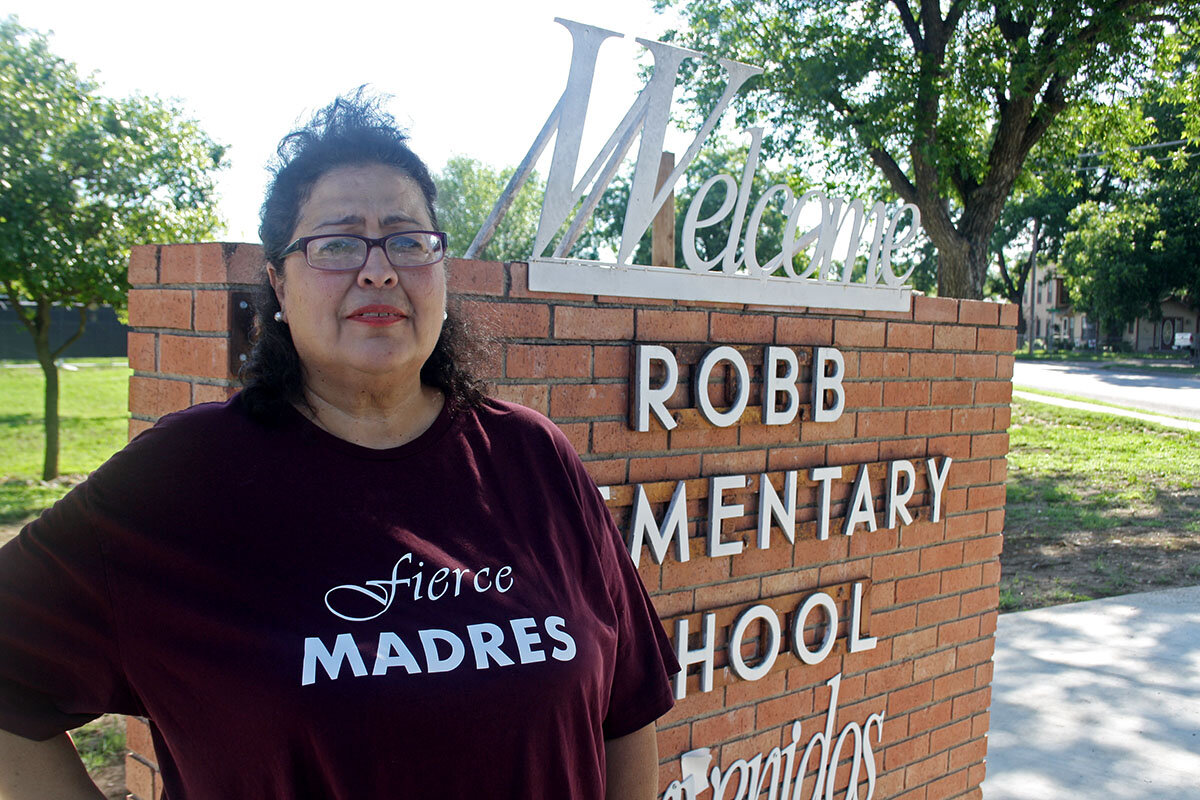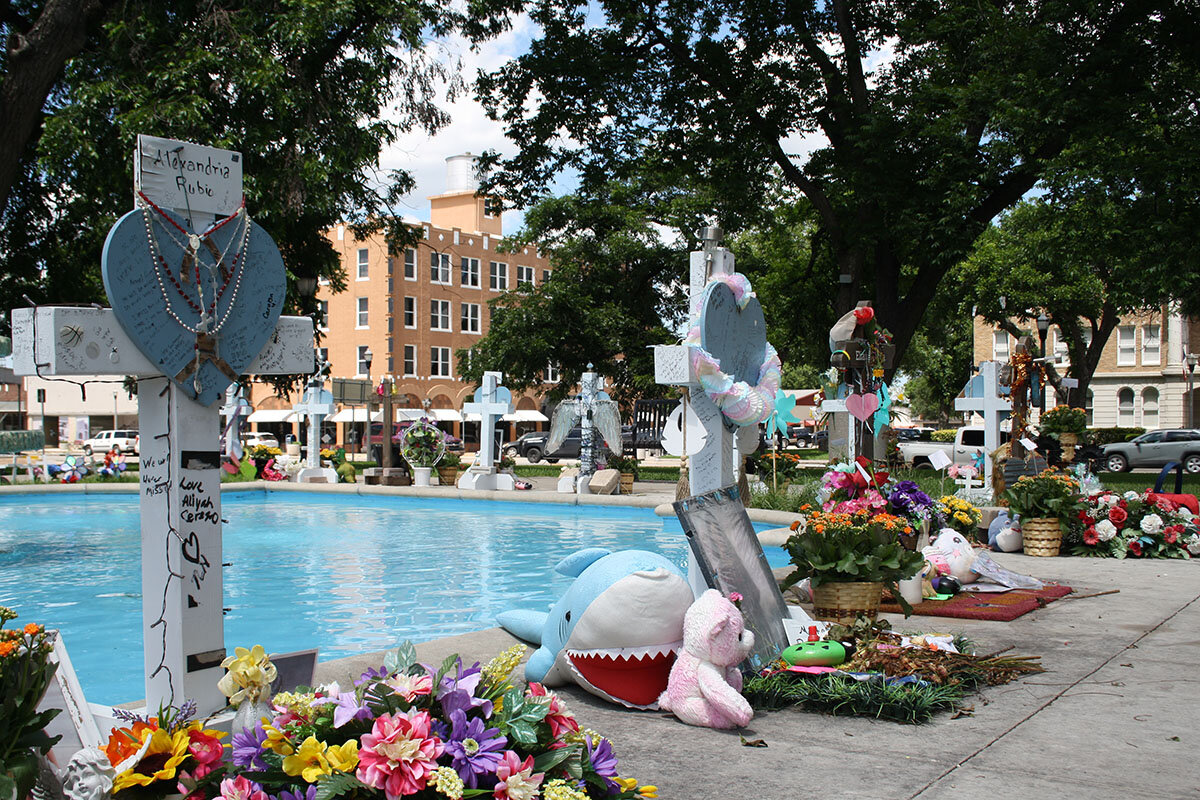One year after Uvalde, three activists share their stories
Loading...
| UVALDE, TEXAS; NASHVILLE, TENN.; AND TYBEE ISLAND, GA.
As a mother, she had to act. When a shooter killed 19 children and two adults at Robb Elementary School in Uvalde, Texas, a year ago, Angie Villescaz felt the tears – and determination – well up in her. She had attended that very same elementary school years ago, and she wanted to do everything in her power to prevent such a tragedy from ever happening again.
So she started organizing to protect children from gun violence. As did Jennifer Hellmer, a mother whose children go to school not far from the Covenant School in Nashville, Tennessee, the site of a mass shooting in March. Activism also gripped Delaney Tarr, who survived the shooting that killed 17 students and staff members at a high school in Parkland, Florida, in 2018.
School shootings in America have become numbingly familiar and leave many people feeling hopeless. But this crucible of profound shock and grief has also spurred some to become agents of change – people like Ms. Villescaz, Ms. Hellmer, and Ms. Tarr. The Monitor interviewed all three about their journey as activists for more restrictive gun laws, particularly in red states that value gun rights.
Why We Wrote This
A story focused onThe crucible of profound shock and grief after school shootings has also spurred some people to become agents of change. One year after Uvalde, three activists share their stories.
“This word, ‘activist,’ it meant nothing – and meant everything,” says Ms. Tarr, now a suburban reporter for a small Atlanta newspaper chain. Her observation captures both the drive and the frustration of those fighting the uphill battle to do something – anything – in a country that stands alone among its wealthy peers in losing children to gun violence.
Polling shows that high-profile shootings usually shift public opinion toward support for greater restrictions on guns, though the effect tends to fade and doesn’t easily translate into legislative action. But what also sprouts in the aftermath of school shootings – and may be more durable in the long run – is grassroots activism.
In Uvalde, families of the victims joined together to demand police accountability and lobbied in Austin to prioritize gun safety. The survivors of the Parkland high school shooting successfully pressed lawmakers to enact a red flag law to remove guns from people deemed a risk to themselves or others. In Nashville, a nonpartisan organization has sprung up to urge action ahead of a special legislative session in August.
These activists confront an apparent paradox: Large majorities of voters across the political spectrum say they support gun safety measures like universal background checks and red flag laws. A recent poll by the Texas Politics Project at the University of Texas at Austin found that 91% of Democrats in Texas think the minimum age to buy a gun should be 21. So do 64% of Republicans.
But those expressions of support don’t mean that voters will punish politicians who fail to act. Unlike activists, most voters don’t prioritize this issue over others, and those who do are often opponents of gun control, not supporters. That’s why GOP legislators fear a primary challenger if they are seen as restricting gun rights. “It’s a hard vote for Republicans,” says Jim Henson, director of the Texas Politics Project.
Yet over time, the work of activists can have an impact, even in Texas, which has seen some of the deadliest mass shootings in recent years. “The organizing has changed the visibility of the issue. But we’ve not seen it translate into policy,” says Mr. Henson.
Few doubt that the road of successful advocacy on such an emotive and hard-fought issue is long and hard. Some people persist; some take a different path. Here are their stories.
The Fierce Madres of Uvalde
Angie Villescaz was involved at the grassroots long before a shooter murdered 21 people at her former elementary school in Uvalde a year ago. Within days of the shooting, Ms. Villescaz had formed Fierce Madres, a group of local Hispanic women advocating for gun safety.
“You’ve got to have moms in there. You’ve got to have madres,” she says of her organization. “If Texas is almost half brown, you can no longer ignore the Hispanic moms in Texas. That’s going to bring the change.”
The group has been part of a spike in political activism here – most notably from relatives of children killed at Robb Elementary School. But it has been a difficult year. Ms. Villescaz has seen more defeats than wins, both in trying to elect reform-minded representatives and in passing gun safety legislation. And unlike her, most activists in Uvalde are new to this.
One year on, grief still permeates – and unites – Uvalde.
Memorials to the victims – 21 white crosses adorned with flowers, messages, toys, and stuffed animals – still stand in the downtown square and in front of the now fenced-off Robb Elementary, which is to be razed. Bright murals of the smiling children look down on roads and intersections. Maroon “Uvalde Strong” signs decorate front yards and business windows.
But the gun-related activism of the past year has divided residents of the rural, politically disengaged town. Hunting is popular here, as are firearms. Everyone knows everyone, and as wounds continue to heal under the wide south Texas sky, politics has complicated the grieving process.
These complications extend to the fate of the school building. Some family members of victims supported the decision to demolish it. Some residents, though, were wary of razing one of Uvalde’s most historically significant buildings, while others argued that losing a social landmark could blight the surrounding community.
Last week, as the first anniversary loomed, the families of the victims were declining interview requests.
Prior to the Robb shooting, Ms. Villescaz had worked on political campaigns in Texas and spent decades advocating for victims of domestic violence. Last year, she ran unsuccessfully in a Democratic state primary. So she had plenty of experience, but as she drove to Uvalde from the Austin area on May 24, 2022, barely able to see through tears, she found a new focus: saving children.
In the first months, she pushed for accountability – specifically for Pedro “Pete” Arredondo, the chief of the school police department, who received heavy criticism after law enforcement waited over an hour outside a classroom before confronting the shooter.
Waiting for his termination frustrated family members of victims and community members, but last August the Uvalde School Board fired him. Eloisa R. Medina, a member of Fierce Madres who had never held political office before, won a City Council seat that Mr. Arredondo had vacated in July.
“We had never had a woman on City Council here in 35 years, and never a Hispanic woman,” says Ms. Villescaz.
But November’s midterm elections delivered a reality check to Uvalde’s burgeoning activists. Republican Gov. Greg Abbott, a stolid opponent of firearm regulation, won 60% of the vote in Uvalde County on his way to reelection. Javier Cazares, whose daughter, Jackie, was killed in the shooting, failed to win a county commissioner’s seat as a write-in candidate.
Since then, several gun safety bills have stalled in the Republican-dominated state Legislature. Sen. Roland Gutierrez, who represents Uvalde, filed two bills; neither received a committee hearing.
Then, earlier this month, a House committee unexpectedly passed a bill to raise the age to purchase semi-automatic rifles to 21 amid persistent public advocacy by Uvalde families.
The vote, which sparked tears of joy from family members who were present, came too late in the legislative session to give the bill any chance of becoming law. Still, activists in Uvalde say they are undeterred and will keep pressing for action.
Ms. Villescaz is also hopeful, but she is aiming her campaign higher, beyond Texas. She points to a bipartisan appetite for some gun reform. Some Republicans in Congress, including Texans, supported Democrats last year in passing a modest gun-safety law, the first such federal legislation since the 1990s.
“If I can’t get it done in Texas, then I’ll go higher with my efforts,” she says. “That’s where our only hope is at.”
Converting energy to action in Nashville
Jennifer Hellmer has been “horrified” by every U.S. school shooting over the past decade. She cried after Sandy Hook in 2012 and nervously texted her teacher friend in Fort Lauderdale after Parkland. Then in March came the fatal shooting of three children and three adults at the Covenant School in Nashville, a few miles from where her own two children go to school.
That week, Ms. Hellmer, a lawyer and a registered Republican, became a gun safety activist. The Covenant shooting “woke me up to the point where I was like, I can’t continue doing nothing and lay my head down at night,” she says. “I do feel a certain amount of guilt for not doing more sooner.”
She began texting with other mothers in the days after the shooting, wondering what could be done. As the group grew, one woman invited everyone over to her backyard, where they sat in lawn chairs with laptops in the shade. They showed up at the State Capitol building, unsure at first where to park their cars or how to find committee hearings. They held signs in favor of risk-protection orders – known nationally as red flag laws – while legislators held votes.
“I had other people who were feeling the same way and experiencing the same types of grief within our community,” she says. “Suddenly all of that energy that I was feeling from an emotional perspective just started getting channeled into action.”
Doing nothing isn’t an option, says Ms. Hellmer, not when the threat of gun violence feels so present in her young family’s life. “I want to be able to look my children in the eyes when they’re older and fully understand the magnitude of this and say, ‘I tried my hardest to protect you.’”
Her group merged with another to form Voices for a Safer Tennessee, a nonpartisan organization that held a protest in Nashville last month where supporters formed a 3-mile human chain to call for gun safety laws. The group says it supports measures that meet Tennessee, a deep-red state, “where it is.” These measures include stronger gun-storage laws, strengthening background checks, and risk-protection orders.
Gov. Bill Lee, a Republican, has called an August special session when the state legislature will consider public-safety measures that “preserve Second Amendment rights.”
Ms. Hellmer, herself a gun owner, says she thinks every responsible gun owner, and the state legislature’s Republican supermajority, could get behind “common-sense” gun regulations.
It won’t be easy, she adds, recalling the “very difficult” conversation at this year’s Easter dinner with her family in rural Tennessee, two weeks after the shooting. Sitting at her grandmother’s table, she discussed gun safety measures with a cousin who hunts and is concerned that even a small concession for gun safety would jeopardize his gun ownership. “I won’t say that I had totally changed his mind, but what I will say is he walked away with education he didn’t have going into it,” she says.
Most of Ms. Hellmer’s career was spent as a criminal defense attorney, so she understands law enforcement. But in the days after Covenant she embarked on a crash course in how state laws are written and passed, she explains as she thumbs through a brown accordion folder with thick stapled packets detailing other states’ legislation and Tennessee’s gun statistics.
As an organizer for Voices for a Safer Tennessee, she knows they need to reach rural districts well before the August special session if representatives are to hear from their constituents that they support gun safety reforms.
At times, Ms. Hellmer sounds more like a longtime political organizer than like someone who has spent less than two months planning Voices’ strategy after putting her preschooler and kindergartner to bed every night.
“We recognize that this is an iceberg and we are chipping away at a public safety issue,” she says. “But we’re not naive, and we’re here to do the work – both short-term and long-term.”
Parkland: from teenage activist to journalist
Just days after she survived the Parkland school massacre, Delaney Tarr stood up at a protest to send a message to Florida’s politicians: Enough of your thoughts and prayers. No more prevarications.
“We are coming after every single one of you and demanding that you take action,” she said.
Back then, aged 17, she stood out with her large glasses, brash attitude, and loud voice powered by the passion of what had become a national tragedy. In the weeks and months that followed, Ms. Tarr began to think that she and her fellow teen activists could change the world. Indeed, that year, Florida’s GOP-run Legislature passed a red flag bill and raised the minimum buying age for firearms to 21. Gov. Rick Scott, a Republican, signed both measures into law.
But success gave way to doubts about what it would take to reduce gun violence and tackle its underlying causes. Five years on, Ms. Tarr and many of the other Parkland activists have faced their own private traumas, along with a burden of public expectations. Some have soldiered on. Others have opted out of the struggle.
Ms. Tarr, who now works as a newspaper reporter in Georgia, is still parsing the meaning of what came out of the mass shooting at Marjory Stoneman Douglas High School and her role in it.
Today, she sees she was put in an “unfair position,” a teenager screaming for action on an issue as complex as gun regulation. “Imagine your thoughts on some of the country’s most divisive and important issues being broadcast nationwide while you’re still trying to figure them out,” she says. “You have that brazenness: ‘I know everything.’”
Did she become a useful prop for gun control advocates? she wonders. Is that too cynical? Perhaps.
“But it’s a cynicism I try to balance out with the [fact that] we really changed the landscape for a lot of young people. That’s the impact that I’m happy we had, and that’s the impact that keeps me from feeling too dark,” she says.
On Feb. 14, 2018, Ms. Tarr was in class when the shooting began. She hid in a closet, wondering if she would be next. In all, 17 students and staff members died.
The next day, a teacher suggested Ms. Tarr speak at a courthouse protest, the first of many public appearances in what became March for Our Lives, one of the most high-profile, youth-led gun control movements seen in years. She was one of the group’s co-founders.
Her exposure to the political process led Ms. Tarr to enroll in a public policy program at American University in Washington. But she never went. Instead, she attended the University of Georgia and went into journalism. She now lives in a state where gun rights are a fact of life: Open carry is the law. As for Florida, lawmakers have tried to lower the buying age for guns to 18, reversing their post-Parkland measure.
Ms. Tarr still speaks out on gun safety, but has few illusions about finding easy fixes to the gun violence that besets communities across the country, including majority-Black and Latino communities whose experiences differ greatly from those of middle-class suburban high schoolers. She calls herself an advocate, not an activist; to her, an activist is who you are – and that’s not how she thinks of herself.
Last year, reporters called her for reaction to the Uvalde massacre in Texas. Ms. Tarr ignored them. Instead, she cried and grieved again. She also reflected on her own post-shooting journey.
“I’m glad we had the opportunity to fight the power. But at the same time, we shouldn’t have had to be doing all that. ... We shouldn’t be the poster children for gun violence, for the things that can ravage a body so horribly and desperately. And it’s not because adults couldn’t do it. They wouldn’t.”









